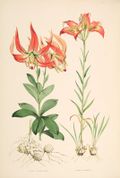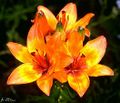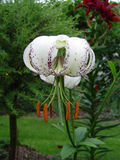Lilium
| Lilium | |
|---|---|
 |
|
| Flora Lilium bulbiferum ssp. croceum | |
| Scientific classification | |
| Kingdom: | Plantae |
| (unranked): | Angiosperms |
| Phylum: | Anthophyta |
| (unranked): | Monocots |
| Order: | Liliales |
| Family: | Liliaceae |
| Subfamily: | Lilioideae |
| Genus: | Lilium L. |
| Species | |
|
See text |
|
The genus Lilium are herbaceous flowering plants growing from bulbs. Most species are native to the temperate northern hemisphere. They comprise a genus of about 110 species in the lily family (Liliaceae).
They are important as large showy flowering garden plants.[1] Additionally, they are important culturally and in literature in much of the world. Some species are sometimes grown or harvested for the edible bulbs.
The species in this genus are the true lilies. Many other plants exist with "lily" in the common English name, some of which are quite unrelated to the true lilies.
Contents |
Range
The range of lilies in the Old World extends across much of Europe, across most of Asia to Japan, south to the Nilgiri mountains in India, and to the Philippines. In the New World they extend from southern Canada through much of the United States.
They are commonly adapted to either woodland habitats, often montane, or sometimes to grassland habitats. A few can survive in marshland and epiphytes are known in southeast Asia (including L. arboricola). In general they prefer moderately acidic or lime-free soils.
Botany
Lilies are leafy stemmed herbs. They form naked or tunic-less scaly underground bulbs which are their overwintering organs. In some North American species the base of the bulb develops into rhizomes, on which numerous small bulbs are found. Some species develop stolons. Most bulbs are deeply buried, but a few species form bulbs near the soil surface. Many species form stem-roots. With these, the bulb grows naturally at some depth in the soil, and each year the new stem puts out adventitious roots above the bulb as it emerges from the soil. These roots are in addition to the basal roots that develop at the base of the bulb.
Most species are deciduous, but a few species (Lilium candidum, Lilium catesbaei) bear a basal rosette of leaves during dormancy.
Seeds ripen in late summer. They exhibit varying and sometimes complex germination patterns, many adapted to cool temperate climates.
The large flowers have six tepals. They are often fragrant, and come in a range of colours ranging through whites, yellows, oranges, pinks, reds and purples. Markings include spots, brush strokes and picotees . The plants are late spring or summer flowering.
Some species formerly included within this genus have now been placed in other genera. These genera include Cardiocrinum, Notholirion, Nomocharis and some Fritillaria.
Taxonomy
Taxonomical division in sections follows the classical division of Comber,[2] species acceptance follows World Checklist of Liliaceae,[3] the taxonomy of section Pseudolirium is from the Flora of North America,[4] the taxonomy of Section Liriotypus is given in consideration of Resetnik et al. 2007,[5] the taxonomy of Chinese species (various sections) follows the Flora of China [6] and the taxonomy of Section Archelirion follows Nishikawa et al.[7] as does the taxonomy of Section Archelirion.[8]
Section Martagon
 |
Lilium distichum | |
 |
Lilium hansonii | |
 |
Lilium martagon | Martagon or Turk's cap lily |
| Lilium medeoloides | ||
 |
Lilium tsingtauense | |
.jpg) |
Lilium debile |
Section Pseudolirium
 |
Lilium bolanderi | Bolander's Lily |
 |
Lilium columbianum | Columbia Lily or Tiger Lily |
 |
Lilium humboldtii | Humboldt's lily |
 |
Lilium kelloggii | |
 |
Lilium rubescens | |
 |
Lilium washingtonianum | Washington Lily, Shasta Lily, or Mt. Hood Lily |
 |
Lilium kelleyanum | |
 |
Lilium maritimum | |
 |
Lilium occidentale | |
 |
Lilium pardalinum | Panther or Leopard lily |
 |
Lilium parryi | |
 |
Lilium parvum | Sierra tiger lily or Alpine lily |
 |
Lilium canadense | Canada Lily or Meadow Lily |
 |
Lilium puberulum | |
 |
Lilium grayi | |
 |
Lilium iridollae | |
| Lilium michiganense | Michigan Lily | |
 |
Lilium michauxii | Carolina Lily |
| Lilium pyrophilum | ||
 |
Lilium superbum | Swamp lily or American tiger lily |
 |
Lilium catesbaei | |
 |
Lilium philadelphicum | Wood lily, Philadelphia lily or prairie lily |
Section Liriotypus
 |
Lilium bulbiferum | Orange Lily or Fire Lily |
 |
Lilium candidum | Madonna lily |
 |
Lilium chalcedonicum | |
 |
Lilium kesselringianum | |
 |
Lilium ledebourii | |
.jpg) |
Lilium szovitsianum | |
| Lilium monadelphum | ||
 |
Lilium pyrenaicum | |
 |
Lilium rhodopeum | |
 |
Lilium akkusianum | |
 |
Lilium bosniacum | |
 |
Lilium carniolicum | |
.jpg) |
Lilium ciliatum | |
 |
Lilium pomponium | Turban lily |
 |
Lilium ponticum | |
 |
Lilium jankae | |
 |
Lilium albanicum | |
 |
Lilium polyphyllum |
Section Archelirion
 |
Lilium auratum | Golden rayed lily of Japan, or Goldband lily |
| Lilium platyphyllum | ||
| Lilium brownii | ||
| Lilium japonicum | ||
| Lilium nobilissimum | ||
| Lilium rubellum | ||
 |
Lilium speciosum | Japanese lily |
Section Sinomartagon
 |
Lilium davidii | |
 |
Lilium duchartrei | |
| Lilium henryi | Tiger Lily or Henry's lily | |
 |
Lilium lancifolium | Tiger Lily |
| Lilium lankongense | ||
| Lilium leichtlinii | ||
| Lilium papilliferum | ||
| Lilium rosthornii | ||
| Lilium amabile | ||
| Lilium callosum | ||
| Lilium cernuum | ||
 |
Lilium concolor | Morning Star Lily |
| Lilium fargesii | ||
| Lilium pumilum | Coral Lily, Low Lily, or Siberian Lily | |
| Lilium xanthellum | ||
| Lilium amoenum | ||
| Lilium bakerianum | ||
| Lilium henrici | ||
| Lilium lijiangense | ||
 |
Lilium lophophorum | |
 |
Lilium mackliniae | Siroi Lily |
| Lilium nanum | ||
.jpg) |
Lilium nepalense | |
| Lilium oxypetalum | ||
| Lilium paradoxum | ||
| Lilium primulinum | ||
| Lilium sempervivoideum | ||
| Lilium sherriffiae | ||
| Lilium souliei | ||
| Lilium stewartianum | ||
| Lilium taliense | ||
 |
Lilium wardii | |
| Lilium arboricola | ||
| Lilium anhuiense | ||
| Lilium brevistylum | ||
 |
Lilium habaense | |
| Lilium huidongense | ||
| Lilium jinfushanense | ||
| Lilium matangense | ||
| Lilium pinifolium | ||
| Lilium pyi | ||
| Lilium saccatum | ||
| Lilium tianschanicum | ||
| Lilium poilanei | ||
| Lilium floridum | ||
| Lilium medogense |
Section Leucolirion
| Lilium leucanthum | ||
| Lilium puerense | ||
 |
Lilium regale | |
| Lilium sargentiae | ||
| Lilium sulphureum | ||
| Lilium formosanum | ||
| Lilium longiflorum | Easter Lily | |
| Lilium philippinense | ||
| Lilium wallichianum | ||
| Lilium wenshanense |
Section Daurolirion
| Lilium pensylvanicum | |
| Lilium maculatum |
Section not specified
| Lilium eupetes |
Uses

Many species are widely grown in the garden in temperate and sub-tropical regions. Sometimes they may also be grown as potted plants. A large number of ornamental hybrids have been developed. They can be used in herbaceous borders, woodland and shrub plantings, and as a patio plant.
Some lilies, especially Lilium longiflorum, as well as a few other hybrids, form important cut flower crops. These tend to be forced for particular markets; for instance, L. longiflorum for the Easter trade, when it may be called the Easter lily.
Lilium bulbs are starchy and edible as root vegetables, although bulbs of some species may be very bitter. The non-bitter bulbs of L. lancifolium, L. pumilum, and especially L. brownii (Chinese: 百合 干; pinyin: bǎihé gān) are grown at large scale in China as a luxury or health food, most often sold in dry form. They are eaten especially in the summer, for their ability to reduce internal heat. They may be reconstituted and stir-fried, grated and used to thicken soup, or processed to extract starch. Their texture and taste draw comparison with the potato, although the individual bulb scales are much smaller.
Lilies are used as food plants by the larvae of some Lepidoptera species including the Dun-bar.
Toxicology
Many varieties of lily are extremely toxic to cats, causing acute renal failure even in small amounts. This is particularly true in the case of Easter lily plants, though other Lilium and the related Hemerocallis can also cause the same symptoms.[9][10][11]
Classification of garden forms


Numerous forms are grown for the garden, and most of these are hybrids. They vary according to their parent species, and are classified in the following broad groups;[12]
- Asiatic hybrids (Division I). These are plants with medium sized, upright or outward facing flowers, mostly unscented. They are derived from central and East Asian species.
- Martagon hybrids (Division II). These are based on L. martagon and L. hansonii. The flowers are nodding, Turk's cap style (with the petals strongly recurved).
- Candidum hybrids (Division III). This includes hybrids of L. candidum with several other mostly European species.
- American hybrids (Division IV). These are mostly taller growing forms, originally derived from L. pardalinum. Many are clump-forming perennials with rhizomatous rootstocks.
- Longiflorum hybrids (Division V). These are cultivated forms of this species and its subspecies. They are most important as plants for cut flowers, and are less often grown in the garden than other hybrids.
- Trumpet lilies (Division VI), including Aurelian hybrids. This group includes hybrids of many Asiatic species, including L. regale and L. aurelianse. The flowers are trumpet shaped, facing outward or somewhat downward, and tend to be strongly fragrant, often especially night-fragrant.
- Oriental hybrids (Division VII). These are based on hybrids of L. auratum and L. speciosum, together with crossbreeds from several mainland Asiatic species. They are fragrant, and the flowers tend to be outward facing. Plants tend to be tall, and the flowers may be quite large. An example is Lilium "Stargazer".
- Other hybrids (Division VIII). Includes all other garden hybrids.
- Species (Division IX). All natural species and naturally occurring forms are included in this group.
Crossing polygon of the genus Lilium
Crossing polygon of the genus Lilium
Propagation and growth
Liliums can be propagated in several ways;
- by division of the bulbs,
- by growing-on bulbils which are adventitious bulbs formed on the stem,
- by scaling, for which whole scales are detached from the bulb and planted to form a new bulb,
- by seed; there are many seed germination patterns, which can be complex.
- by micropropagation techniques;[13] commercial quantities of lilies are often propagated in vitro and then planted out to grow into salable sized plants.
Names
The botanic name Lilium is the Latin form and is a Linnaean name. The Latin name is derived from the Greek leirion, which is generally assumed to be the Madonna lily.[14] The word was borrowed from Coptic (dial. Fayyumic) hleri, from standard hreri, from Demotic hrry, from Egyptian hrṛt "flower".
Gallery
|
Orange Lily showing stamens with pollen-covered anthers. Ontario, Canada. June 2002. |
 Pollen of Lilium auratum (Oriental Lily) Back-scattered electron microscope image |
 Microscopic view of Lily pollen 100X |
See also
- Lily seed germination types
Notes
- ↑ http://www.wonderflowers.be/ENG/Explanation-Lily.html
- ↑ Harold Comber, 1949. "A new classification of the genus Lilium." Lily Yearbook, Royal Hortic. Soc., London. 15:86–105.
- ↑ Govaerts, R. (2006). World Checklist of Liliaceae. The Board of Trustees of the Royal Botanic Gardens, Kew. Published on the Internet; accessed 15 September 2006; 20:36 GMT
- ↑ Flora of North America, Vol. 26, Online
- ↑ I. Resetnik, Z. Liber, Z. Satovic, P. Cigic, T. Nikolic: Molecular phylogeny and systematics of the Lilium carniolicum group (Liliaceae) based on nuclear ITS sequences, in: Plant Systematics and Evolution, 265: 45–58 (2007)
- ↑ Flora of China, Vol. 24, eFloras.org
- ↑ Nishikawa Tomotaro, Okazaki Keiichi, Arakawa Katsuro, Nagamine Tsukasa: Phylogenetic Analysis of Section Sinomartagon in Genus Lilium Using Sequences of the Internal Transcribed Spacer Region in Nuclear Ribosomal DNA, in: 育種学雑誌 Breeding science, Vol.51, No.1, pp. 39–46
- ↑ Nishikawa Tomotaro, Okazaki Keiichi, Nagamine Tsukasa: Phylogenetic Relationships among Lilium auratum Lindley, L. auratum var. platyphyllum Baker and L. rubellum Baker Based on Three Spacer Regions in Chloroplast DNA, in: 育種学雑誌 Breeding science, Vol.52, No.3, pp. 207–213
- ↑ "Acute renal failure caused by lily ingestion in six cats [J Am Vet Med Assoc. 2002] - PubMed Result". http://www.ncbi.nlm.nih.gov/entrez/query.fcgi?cmd=Retrieve&db=PubMed&list_uids=12680447&dopt=Abstract. Retrieved 2008-06-22.
- ↑ Hall J: Nephrotoxicity of Easter Lily (Lilium longiflorum) when ingested by the cat, Proc Annu Meet Am Vet Int Med 6:121, 1992.
- ↑ Volmer P: Easter lily toxicosis in cats, Vet Med 331, April 1999.
- ↑ North American Lily Society: Types of Lilies
- ↑ Hcmuaf.edu.ven
- ↑ "Classification". http://members.shaw.ca/lilynet/netlil/id35.htm. Retrieved 2008-06-22.
External links
- Flora Europaea: Lilium
- Flora of China: Lilium
- Flora of Nepal: Lilium species list
- Flora of North America: Lilium
- Online Lily Register, over 9400 entries Lilium
- de Florum: Lilium species
- North American Lily Society
- Royal Horticultural Society Lily Group
- 1 2 3 Time-lapse videos
- RHS Lily Group Seed Exchange
- the-genus-lilium
- Lilium at the Encyclopedia of Life
